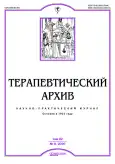Contrast-induced acute kidney injury in patients with stable coronary artery disease: the most important risk factors and prevalence
- Authors: Mironova O.I.1, Staroverov I.I.2, Sivakova O.A.2, Fomin V.V.1
-
Affiliations:
- Sechenov First Moscow State Medical University (Sechenov University)
- National Medical Research Center for Cardiology
- Issue: Vol 92, No 9 (2020)
- Pages: 44-48
- Section: Original articles
- URL: https://journals.rcsi.science/0040-3660/article/view/46854
- DOI: https://doi.org/10.26442/00403660.2020.09.000751
- ID: 46854
Cite item
Full Text
Abstract
Aim. The aim of our study was to assess the prevalence of contrast-induced acute kidney injury (CI-AKI) in patients with stable coronary artery disease (CAD) receiving optimal medical treatment with indications to coronary angiography and intraarterial administration of contrast agents.
Materials and methods. 1023 patients with stable CAD were included in the open prospective observational cohort study. The CI-AKI was defined as a rise in serum creatinine ≥25% from baseline. The mean age of the study group was 61.7±10.1 years; 72.4% were males and 84.4% had arterial hypertension. A multiple logistic regression model of prediction of CI-AKI was created.
Results. CI-AKI developed in 132 (12.9%) of the patients. The multiple logistic regression model included gender, BMI, weight, age, heart failure, diabetes mellitus, arterial hypertension, anemia, hyperuricemia, proteinuria and baseline serum creatinine. Area under the curve for the model was 0.749 (95% confidence interval 0.703–0,795; p<0.0001). When trying to build a prognostic model, including baseline GFR and contrast volume, the model lost significance and the AUC diminished.
Conclusion. The CI-AKI remains quite a common kidney injury developing in patients with stable CAD undergoing percutaneous interventions. Several risk factors need to be assessed very carefully before any intervention requiring intraarterial contrast media administration especially in patients with comorbidities.
Full Text
##article.viewOnOriginalSite##About the authors
O. I. Mironova
Sechenov First Moscow State Medical University (Sechenov University)
Author for correspondence.
Email: mironova_o_yu@staff.sechenov.ru
ORCID iD: 0000-0002-5820-1759
к.м.н., доц. каф. факультетской терапии №1 Института клинической медицины им. Н.В. Склифосовского ФГАОУ ВО «Первый МГМУ им. И.М. Сеченова» (Сеченовский Университет)
Russian Federation, MoscowI. I. Staroverov
National Medical Research Center for Cardiology
Email: mironova_o_yu@staff.sechenov.ru
д.м.н., рук. отд. неотложной кардиологии ФГБУ «НМИЦ кардиологии»
Russian Federation, MoscowO. A. Sivakova
National Medical Research Center for Cardiology
Email: mironova_o_yu@staff.sechenov.ru
ORCID iD: 0000-0002-0060-095X
к.м.н., зав. отд-нием артериальной гипертонии ФГБУ «НМИЦ кардиологии»
Russian Federation, MoscowV. V. Fomin
Sechenov First Moscow State Medical University (Sechenov University)
Email: mironova_o_yu@staff.sechenov.ru
ORCID iD: 0000-0002-2682-4417
чл.-кор. РАН, д.м.н., проф., проректор по клинической работе и дополнительному профессиональному образованию, зав. каф. факультетской терапии №1 Института клинической медицины им. Н.В. Склифосовского ФГАОУ ВО «Первый МГМУ им. И.М. Сеченова» (Сеченовский Университет)
Russian Federation, MoscowReferences
- McCullough PA, Adam A, Becker CR, et al. Risk Prediction of Contrast-Induced Nephropathy. Am J Cardiol. 2006;98(6 Suppl. 1):27-36. doi: 10.1016/j.amjcard.2006.01.022
- KDIGO Working Group. Clinical Practice Guideline for Acute Kidney Injury. Kidney Int Suppl. 2012;2(1):124-38. http://www.kdigo.org/ clinical_practice_guidelines/pdf/KDIGO AKI Guideline.pdf
- Mehran R, Dangas GD, Weisbord SD. Contrast-Associated Acute Kidney Injury. N Engl J Med. 2019;380(22):2146-55. doi: 10.1056/NEJMra1805256
- Kellum JA, Zarbock A, Nadim MK. What endpoints should be used for clinical studies in acute kidney injury? Intensive Care Med. 2017;43(6):901-3. doi: 10.1007/s00134-017-4732-1
- Maioli M, Toso A, Gallopin M, et al. Preprocedural score for risk of contrast-induced nephropathy in elective coronary angiography and intervention. J Cardiovasc Med. 2010;11(6):444-9. doi: 10.2459/JCM.0b013e328335227c
- Zeng J-feng, Chen S-qun, Ye J-feng, et al. A simple risk score model for predicting contrast-induced nephropathy after coronary angiography in patients with diabetes. Clin Exp Nephrol. 2019;23(7):969-81. doi: 10.1007/s10157-019-01739-0
- Mehran R, Aymong ED, Nikolsky E, et al. A simple risk score for prediction of contrast-induced nephropathy after percutaneous coronary intervention: Development and initial validation. J Am Coll Cardiol. 2004;44(7):1393-9. doi: 10.1016/j.jacc.2004.06.068
- Huang C, Li S, Mahajan S, et al. Development and Validation of a Model for Predicting the Risk of Acute Kidney Injury Associated With Contrast Volume Levels During Percutaneous Coronary Intervention. 2019;L(11):1-13. doi: 10.1001/jamanetworkopen.2019.16021
- Вершинина Е.О., Репин А.Н. Контраст-индуцированная нефропатия при плановых эндоваскулярных вмешательствах на коронарных артериях. Сибирский журн. клинической и экспериментальной медицины. 2016;31(3):61-7 [Vershinina EO, Repin АN. Contrast-induced nephropathy after elective percutaneous coronary interventions. Siberian Journal of Clinical and Experimental Medicine (In Russ.)]. doi: 10.29001/2073-8552-2016-31-3-61-67
- Zhao F, Lei R, Yang SK, et al. Comparative effect of iso-osmolar versus low-osmolar contrast media on the incidence of contrast-induced acute kidney injury in diabetic patients: A systematic review and meta-analysis. Cancer Imaging. 2019;19(1):1-8. doi: 10.1186/s40644-019-0224-6
- Maioli M, Toso A, Leoncini M, et al. Persistent renal damage after contrast-induced acute kidney injury: Incidence, evolution, risk factors, and prognosis. Circulation. 2012;125(25):3099-107. doi: 10.1161/CIRCULATIONAHA.111.085290
- Lakhal K, Robert-Edan V, Ehrmann S. In the Name of Contrast-Induced Acute Kidney Injury… Chest. 2020;157(4):751-2. doi: 10.1016/j.chest.2019.12.009
- Caspi O, Habib M, Cohen Y, et al. Acute Kidney Injury After Primary Angioplasty: Is Contrast-Induced Nephropathy the Culprit? J Am Heart Assoc. 2017;6(6):1-10. doi: 10.1161/JAHA.117.005715
- Yarkova NA, Borovkov NN. Algorithm for early diagnosis of contrast-induced nephropathy using biomarkers of renal damage. Sovrem Tehnol Med. 2017;9(4):156-61. doi: 10.17691/stm2017.9.4.19
Supplementary files










